
A | B | C | D | E | F | G | H | CH | I | J | K | L | M | N | O | P | Q | R | S | T | U | V | W | X | Y | Z | 0 | 1 | 2 | 3 | 4 | 5 | 6 | 7 | 8 | 9
A dive computer, personal decompression computer or decompression meter is a device used by an underwater diver to measure the elapsed time and depth during a dive and use this data to calculate and display an ascent profile which, according to the programmed decompression algorithm, will give a low risk of decompression sickness.[1][2] A secondary function is to record the dive profile, warn the diver when certain events occur, and provide useful information about the environment.
Most dive computers use real-time ambient pressure input to a decompression algorithm to indicate the remaining time to the no-stop limit, and after that has passed, the minimum decompression required to surface with an acceptable risk of decompression sickness. Several algorithms have been used, and various personal conservatism factors may be available. Some dive computers allow for gas switching during the dive, and some monitor the pressure remaining in the scuba cylinders. Audible alarms may be available to warn the diver when exceeding the no-stop limit, the maximum operating depth for the gas mixture, the recommended ascent rate, decompression ceiling, or other limit beyond which risk increases significantly.
The display provides data to allow the diver to avoid decompression, or to decompress relatively safely, and includes depth and duration of the dive. This must be displayed clearly, legibly, and unambiguously at all light levels. Several additional functions and displays may be available for interest and convenience, such as water temperature and compass direction, and it may be possible to download the data from the dives to a personal computer via cable or wireless connection. Data recorded by a dive computer may be of great value to the investigators in a diving accident, and may allow the cause of an accident to be discovered.
Dive computers may be wrist-mounted or fitted to a console with the submersible pressure gauge. A dive computer is perceived by recreational scuba divers and service providers to be one of the most important items of safety equipment.[3] It is one of the most expensive pieces of diving equipment owned by most divers. Use by professional scuba divers is also common, but use by surface-supplied divers is less widespread, as the diver's depth is monitored at the surface by pneumofathometer and decompression is controlled by the diving supervisor. Some freedivers use another type of dive computer to record their dive profiles and give them useful information which can make their dives safer and more efficient, and some computers can provide both functions, but require the user to select which function is required.
Purpose
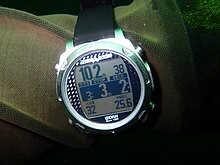

The primary purpose of a decompression computer is to facilitate safe decompression by an underwater diver breathing a suitable gas at ambient pressure, by providing information based on the recent pressure exposure history of the diver that allows an ascent with acceptably low risk of developing decompression sickness. Dive computers address the same problem as decompression tables, but are able to perform a continuous calculation of the theoretical partial pressure of inert gases in the body based on the actual depth and time profile of the diver and the decompression model used by the computer.[1] As the dive computer automatically measures depth and time, it is able to warn of excessive ascent rates and missed decompression stops and the diver has less reason to carry a separate dive watch and depth gauge. Many dive computers also provide additional information to the diver including ambient temperature, partial pressure of oxygen in the breathing gas at ambient pressure, accumulated oxygen toxicity exposure data, a computer-readable dive log, and the pressure of the remaining breathing gas in the diving cylinder. This recorded information can be used for the diver's personal log of their activities or as important information in medical review or legal cases following diving accidents.[4][5][2]
Because of the computer's ability to continually re-calculate based on changing data, the diver benefits by being able to remain underwater for longer periods at acceptable risk. For example, a recreational diver who plans to stay within "no-decompression stop" limits can in many cases simply ascend a few feet each minute, while continuing the dive, and still remain within reasonably safe limits, rather than adhering to a pre-planned bottom time and then ascending directly. Multi-level dives can be pre-planned with traditional dive tables or personal computer and smartphone apps, or on the fly using waterproof dive tables, but the additional calculations become complex, and the plan may be cumbersome to follow, and the risk of errors rises with profile complexity. Computers allow for a certain amount of spontaneity during the dive, and automatically take into account deviations from the dive plan.[6]
Dive computers are used to safely calculate decompression schedules in recreational, scientific, and military diving operations. There is no reason to assume that they cannot be valuable tools for commercial diving operations, especially on multi-level dives.[7]
Components

Some components are common to all models of dive computer as they are essential to the basic function:
- ambient pressure transducer
- pressure sensor
- Component that converts ambient pressure to an electrical signal[8] Piezoresistive pressure sensors are frequently used for this purpose.[9][10]
- analog-to-digital converter
- Component that converts the voltage output from the pressure transducer to a binary signal that can be processed by the computer.[8]
- buttons
- User input interface in the form of push-buttons or external contacts which accept manual input from the user to set the user preferences and select display options.[11][2]
- clock
- Circuitry that synchronises the steps of the processor and keeps track of elapsed time. It may also keep track of time of day.[8]
- display
- Screen to present the results of computation to the diver in real time.[8]
- faceplate
- The transparent glass or plastic window covering the screen. Tempered glass and synthetic sapphire are most scratch resistant, but brittle, and can fracture on impact, causing the housing to leak, which can destroy the electronics. These materials are popular on wristwatch style units, which are expected to be worn out of the water. The larger units are more likely to be worn only while diving, and the more impact resistant polycarbonate faceplates used for these computers are more sensitive to scratching, but are less likely to flood. Disposable transparent self-adhesive faceplate protectors are available for some models.[2]
- housing
- The waterproof container in which the other components are installed to protect them from the environment.[8] Three basic form factors are used: Wristwtch, wrist or console mount circular (puck), Rectangular or contoured wrist mount, and housed smartphone.[12][13]
- microprocessor
- The logic-processing microcircuitry that converts the input signals into real time output data modelling the diver's decompression status using the chosen algorithm and other input data.[8]
- power supply
- The battery that provides electrical power to run the device. It may be rechargeable, or user replaceable, or may require replacement by an authorised agent or the manufacturer.[8]
- random access memory (RAM)
- Temporary storage for the variable data and results of computation.[8]
- read only memory (ROM)
- Non-volatile memory containing the program and constants used in the algorithm.[8]
- strap
- Band used to secure the housing to the user's wrist. Several types may be used. Double straps may be used for greater security. An alternative to straps is console mounting, usually limited to puck form factor recreational dive computers.
- temperature sensor
- Component that measures the temperature of the pressure transducer to compensate for temperature variations. The output may be recorded and displayed, but the primary function is to allow accurate pressure measurement. [14]
Additional components may be necessary for additional or extended features and functionality.
- accelerometer
- used to detect directional tapping input and pitch and tilt angles.[15]
- Bluetooth hardware
- Used for communication with smartphones or personal computers to upload data and download firmware updates.[11]
- buzzer
- Used to provide audible and vibratory alarms.[11]
- external electrical contacts
- May be used for several purposes at the surface, including battery charging and communication with a personal computer.[16]
- GPS receiver
- Used for position identification at the surface.[16]
- fluxgate compass
- Used to provide compass functionality for navigation.[16]
- infrared data transfer hardware
- Used for date transfer to and from personal computer.[2]
- light sensor
- Used to provide automatic display intensity[16]
- screen protector
- Transparent sacrificial film or lens covering the screen to protect the screen against scratches.[11]
- ultrasonic communications hardware
- Used for wireless communications with pressure sensors on gas cylinders for gas-integrated systems, and in some cases, other peripherals.[11]
- watertight electrical connections
- To receive input from oxygen cells, and to communicate with electronically controlled rebreathers.[17]
- wireless charging coil
- Used to recharge the battery.[18]
This section needs expansion with: more optional components. You can help by adding to it. (April 2024) |
Function
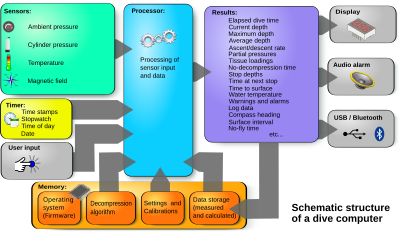
Dive computers are battery-powered computers within a watertight and pressure resistant case. These computers track the dive profile by measuring time and pressure. All dive computers measure the ambient pressure to model the concentration of gases in the tissues of the diver. More advanced dive computers provide additional measured data and user input into the calculations, for example, the water temperature, gas composition, altitude of the water surface,[7] or the remaining pressure in the diving cylinder. Dive computers suitable for calculating decompression for rebreather diving need to measure the oxygen partial pressure in the breathing loop. A dive computer may be used as the control unit for an electronically controlled closed circuit rebreather, in which case it will calculate oxygen partial pressure in the loop using the output from more than one oxygen sensor.[19]
The computer uses the pressure and time input in a decompression algorithm to estimate the partial pressure of inert gases that have been dissolved in the diver's tissues.[20] Based on these calculations, the computer estimates when a risk-free direct ascent to the surface is no longer possible, and what decompression stops would be needed based on the profile of the dive up to that time and recent hyperbaric exposures which may have left residual dissolved gases in the diver.[20]
Many dive computers are able to produce a low risk decompression schedule for dives that take place at altitude, which requires longer decompression than for the same profile at sea level, because the computers measure the atmospheric pressure before the dive and take this into account in the algorithm. Many dive computers continuously monitor the pressure as long as the battery has a charge, so when divers travel before or after diving and particularly when they fly, they should transport their dive computer with them in the same pressure regime (carry on baggage, not checked in and carried in the hold) so that the computer can measure the pressure profile that their body has undergone and take it into account in consequent dives.[citation needed] Older computers that are powered down completely when switched off will not benefit by this process.
Many computers have some way for the user to adjust decompression conservatism. This may be by way of a personal factor, which makes an undisclosed change to the algorithm arbitrarily decided by the manufacturer, or the setting of gradient factors, a way of reducing the permitted supersaturation of tissue compartments by specific ratios, which is well defined in the literature, leaving the responsibility for making informed decisions on personal safety to the diver.[21][16]
Algorithms
The decompression algorithms used in dive computers vary between manufacturers and computer models. Examples of decompression algorithms are the Bühlmann algorithms and their variants, the Thalmann VVAL18 Exponential/Linear model, the Varying Permeability Model, and the Reduced Gradient Bubble Model.[2] The proprietary names for the algorithms do not always clearly describe the actual decompression model. The algorithm may be a variation of one of the standard algorithms, for example, several versions of the Bühlmann decompression algorithm are in use. The algorithm used may be an important consideration in the choice of a dive computer. Dive computers using the same internal electronics and algorithms may be marketed under a variety of brand names.[22]
The algorithm used is intended to inform the diver of a decompression profile that will keep the risk of decompression sickness (DCS) to an acceptable level. Researchers use experimental diving programmes or data that has been recorded from previous dives to validate an algorithm. The dive computer measures depth and time, then uses the algorithm to determine decompression requirements or estimate remaining no-stop times at the current depth. An algorithm takes into account the magnitude of pressure reduction, breathing gas changes, repetitive exposures, rate of ascent, and time at altitude. Algorithms are not able to reliably account for age, previous injury, ambient temperature, body type, alcohol consumption, dehydration, and other factors such as patent foramen ovale, because the effects of these factors have not been experimentally quantified, though some may attempt to compensate for these by factoring in user input, and for diver peripheral temperature and workload by having sensors that monitor ambient temperature and cylinder pressure changes as a proxy.[23] Water temperature is known to be a poor proxy for body temperature, as it does not account for the effectiveness of the diving suit or heat generated by work or active heating systems.[24]
As of 2009[update], the newest dive computers on the market used:
- Liquivision X1: V-Planner Live: VPM-B Varying Permeability Model and GAP for X1: Bühlmann GF (Buhlman with Gradient Factors)[citation needed]
- Mares: Mares-Wienke Reduced Gradient Bubble Model[citation needed][clarification needed]
- Pelagic Pressure Systems: modified Haldanean/DSAT Database or Bühlmann ZH-L16C(called Z+)[citation needed]
- Seiko: Bühlmann ZH-L12 as modified by Randy Bohrer.[25]
- Suunto: Suunto-Wienke Reduced Gradient Bubble Model. The Suunto folded RGBM is not a true RGBM algorithm, which would be computationally intensive, but a Haldanean model with additional bubble limitation factors.[2]
- Uwatec: Bühlmann ZH-L8 /ADT (Adaptive), MB (Micro Bubble), PMG (Predictive Multigas), Bühlmann ZH-L16 DD (Trimix)[citation needed]
- Heinrichs Weikamp OSTC and DR5: Bühlmann ZH-L16 and Bühlmann ZH-L16 plus Erik Baker's gradient factors deep stop algorithm both for open circuit and fixed set point closed circuit rebreather.[citation needed]
As of 2012[update]:
- Cochran EMC-20H: 20-tissue Haldanean model.[7]
- Cochran VVAL-18: nine-tissue Haldanean model with exponential ongasing and linear offgasing.[7]
- Delta P: 16-tissue Haldanean model with VGM (variable gradient model, i.e., the tolerated supersaturation levels change during the dive as a function of the profile, but no details are provided as to how this is done).[7]
- Mares: ten-tissue Haldanean model with RGBM;[7] the RGBM part of the model adjusts gradient limits in multiple-dive scenarios through undisclosed "reduction factors".[26]: 16–20
- Suunto: nine-tissue Haldanean model with RGBM;[7] the RGBM part of the model adjusts gradient limits in multiple-dive scenarios through undisclosed "reduction factors".[26]: 16–20
- Uwatec: ZH-L8 ADT (Adaptive), MB (Micro Bubble), PMG (Predictive Multigas), ZH-L16 DD (Trimix).
As of 2019[update]:
- Aqualung: Pelagic Z+ – a proprietary algorithm based on Bühlmann ZH-L16C algorithm.[27]
- Cressi: Haldane and Wienke RGBM algorithm.[27][clarification needed]
- Garmin: Bühlmann ZH-L16C algorithm.[27]
- Oceanic: Dual Algorithm: Pelagic Z+ (ZH-L16C) and Pelagic DSAT.[27]
- ScubaPro: ZH-L8 ADT (Adaptive), MB (Micro Bubble), PMG (Predictive Multigas), ZH-L16 DD (Trimix).
- Shearwater: Bühlmann ZH-L16C with user selectable gradient factors or optional VPM-B and VPM-B/GFS.[27][21]
As of 2021[update]:
- Aqualung: Pelagic Z+ – a proprietary algorithm developed by Dr. John E. Lewis, based on Bühlmann ZH-L16C algorithm. Conservatism may be adjusted by altitude setting, deep stops, and safety stops.[23]
- Atomic: "Recreational RGBM" based on the Wienke model, using user input of age, selected risk level, and exertion level to adjust conservatism.[23]
- Cressi: RGBM. User settings for conservatism and optional deep and safety stops.[23]
- Garmin: Bühlmann ZH-L16C, with a choice of three preset conservatism settings or customisable gradient factors, and customisable safety stops.[23]
- Mares: RGBM or Bühlmann ZH-L16C GF (Gradient Factor) depending on model. Preset and customisable conservatism settings.[23]
- Oceanic: User option of dual algorithms: Pelagic Z+ (ZH-L16C) and Pelagic DSAT.[23]
- Oceans: Bühlmann ZH-L16C GF (Gradient Factor). Preset conservatism settings.
- Ratio: Bühlmann ZH-L16B and VPM-B, user settable Gradient Factors (GFL/GFH) for Bühlmann and user settable Bubble Radius for VPM.
- ScubaPro: ZH-L16 ADT MB PMG. Predictive multi-gas modified algorithm, with various conservatism options with user inputs of experience level, age and physical condition, which are assumed to have some influence on gas elimination rate. Input from breathing rate, skin temperature and heart rate monitor is also available and can be used by the algorithm to estimate a workload condition, which is used to modify the algorithm.[23]
- Shearwater: Bühlmann ZH-L16C with optional VPM-B, VPM-B/GFS and DCIEM. The standard package is Bühlmann with user selectable gradient factors, and the option to enable VPM software which may be used in open-circuit tech and rebreather modes, or enable DCIEM which may be used in air and single-gas nitrox modes. VPM-B/GFS is a combination of the two models which applies the ceiling from the more conservative model for each stop.[23][28] The current decompression ceiling may be displayed as an option and the algorithm will calculate decompression at any depth below the ceiling. The GFS option is a hybrid that automatically chooses the decompression ceiling from the more conservative of the VPM-B profile and a Bühlmann ZH-L16C profile. For the Bühlmann profile a single gradient factor is used, adjustable over a range of 70% (most conservative) to 99% (least conservative), the default is 90%. The DCIEM model differs from ZH-L16C and VPM which are parallel models and assume that all compartments are exposed to ambient partial pressures and no gas interchange occurs between compartments. A serial model assumes that the diffusion takes place through a series of compartments, and only one is exposed to the ambient partial pressures.[29]
- Suunto: RGBM based algorithm with conservatism settings, known to be a comparatively conservative algorithm. There are various versions used in different models. The technical computers use an algorithm that claims flexibility through the use of continuous decompression, which means the current ceiling is displayed instead of a stop depth.
As of 2023[update]:
- Shearwater Research has supplied dive computers to the US Navy with an exponential/linear algorithm bases on the Thalman algorithm since Cochran Undersea Technology closed down after the death of the owner. This algorithm is not as of 2024 available to the general public on Shearwater computers, although the algorithm is freely available and known to be lower risk than the Buhlmann algorithm for mixed gas and constant set-point CCR diving at deeper depths, which is the primary market for Shearwater products.[32][33]
Display information

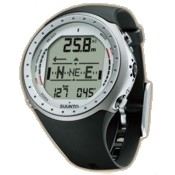
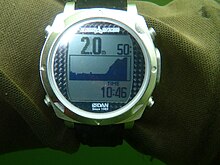
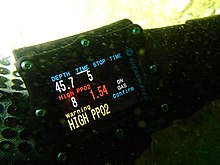

Dive computers provide a variety of visual dive information to the diver, usually on a LCD or OLED display. More than one screen arrangement may be selectable during a dive, and the primary screen will display by default and contain the safety critical data. Secondary screens are usually selected by pressing one or two buttons one or more times, and may be transient or remain visible until another screen is selected. All safety critical information should be visible on any screen that will not automatically revert within a short period, as the diver may forget how to get back to it and this may put them as significant risk. Some computers use a scroll through system which tends to require more button pushes, but is easier to remember, as eventually the right screen will turn up, others may use a wider selection of buttons, which is quicker when the sequence is known, but easier to forget or become confused, and may demand more of the diver's attention, :[11][16]
Most dive computers display the following basic dive profile and no-stop status information during the dive. This information includes safety critical information, and is usually displayed on the default underwater display, and some may be shown on all underwater displays:[34][21]
- Current depth (derived from ambient pressure).
- Maximum depth reached on the current dive.
- No-stop time, the time remaining at the current depth without the need for decompression stops on ascent.
- Elapsed dive time of the current dive.
Many dive computers also display additional information. Some of this is safety-critical for decompression, and would usually be displayed on all screens available underwater, or have a timed default return to the primary screen: Most of the non-critical information is likely to be useful on at least some dives, and may be displayed on a secondary screen layout which can be selected during the dive.[19]
- Total ascent time, or time to surface (TTS) assuming immediate ascent at recommended rate, and decompression stops as indicated. When multiple gases are enabled in the computer, the time to surface may be predicted based on the optimum gas being selected, during ascent, but the actual time to surface will depend on the actual gas selected, and may be longer than the displayed value. This does not invalidate the decompression calculation, which accounts for the actual exposure and gas selected.[16][11]
- Required decompression stop depth and time, also assuming immediate ascent at recommended rate. The depth and duration of the first stop are usually displayed prominently.[16][21]
- Ambient temperature,(actually temperature of the pressure transducer). This may be a default display or a user selected setting, and may not be on the primary display, as it is not safety-critical information.[14]
- Current ascent rate. This may be displayed as an actual speed of ascent, or a relative rate compared to the recommended rate.[11]
- Dive profile (often not displayed during the dive, but transmitted to a personal computer). Not a safety-critical information, so usually on a temporary secondary display if available[16]
- Gas mixture in use, as selected by the user.[16][11]
- Oxygen partial pressure at current depth, based on selected gas mixture.[16][11]
- Cumulative oxygen toxicity exposure (CNS), computed from measured pressure and time and selected gas mixture.[16][11]
- Battery charge status or low battery warning.[16][11]
- Time of day, often with a 12hour or 24 hour format option.[21]
- Compass heading, using a flux gate sensor, with tilt corrections. When available this is usually combined with displays of all safety critical data, so that it does not have to automatically revert to the primary display layout.[11]
A few computers will display additional information on decompression status after the no-stop limit has been exceeded. These data may be selected as optional display settings by the diver, and may require a more comprehensive understanding of decompression theory and modelling than provided by recreational diver training. They are intended as information that may help a technical diver make a more informed decision while dealing with a contingency that affects decompression risk. [35]
- At depth + 5 minutes, (@+5), shows the effect on time to surface of remaining at the current depth on the current breathing gas for five more minutes. The display will show the amended TTS.[35]
- Delta + 5 (Δ+5) is the change in time to surface if remaining at the same depth on the same gas for 5 minutes longer. This value will be positive if ingassing, negative if outgassing, and 0 if the extra exposure has no net effect on computed decompression obligation. This is useful for multi-level dives, where it helps estimate whether there will still be enough breathing gas for the ascent.[35]
- Decompression ceiling, the depth at which calculated supersaturation of the controlling tissue is at the maximum permissible level according to the algorithm. This is the shallowest depth to which the diver can ascend with acceptable decompression risk according to the chosen constraints. This depth will be equal to or shallower than the current obligatory stop depth and deeper than the next obligatory stop. When decompression is completed, the ceiling will be zero.[35]
- Current gradient factor (GF99), an indication of the diver's current proximity to the baseline M-value of the algorithm in the limiting tissue.If it exceeds 100% then the diver is oversaturated according to the algorithm's least conservative setting. This value will slowly decrease at each decompression stop, and increase during the ascent to the next stop. This functionality may be useful in a contingency when the diver needs to exit the water as soon as possible but at a reasonable decompression risk. Responsible use of this feature requires a good understanding of the theory of decompression and how it is modeled by the computer.[35]
- Surfacing gradient factor, The calculated gradient factor for the controlling tissue if the diver were to surface directly from the current depth, without any stops. The figure shown is a percentage of the calculated M-value at that stage of the dive. If it exceeds 99%, the risk of DCS is higher than for the baseline M-value, and if lowe, then the risk is lower than for the baseline M-value, When indicated decompression clears, it will be at the GF-Hi value the diver selected, This is an optional way of monitoring decompression status which could be useful in an emergency.[35]
Some computers, known as air-integrated, or gas-integrated, are designed to display information from a diving cylinder pressure sensor, such as:
- Gas pressure.[36][11]
- Estimated remaining air time (RAT) based on available gas, rate of gas consumption and ascent time.[36][11]
Some computers can provide a real time display of the oxygen partial pressure in the rebreather. This requires an input from an oxygen cell. These computers will also calculate cumulative oxygen toxicity exposure based on measured partial pressure.[19]
Some computers can display a graph of the current tissue saturation for several tissue compartments, according to the algorithm in use.[36][11]
Some information, which has no practical use during a dive, is only shown at the surface to avoid an information overload of the diver during the dive:[19]
- "Time to Fly" display showing when the diver can safely board an airplane.
- Desaturation time, the estimated time required to return all tissues to surface pressure dissolved gas equilibrium.
- A log of key information about previous dives – date, start time, maximum depth, duration, and possibly others.
- Maximum non-decompression bottom times for subsequent dives based on the estimated residual concentration of the inert gases in the tissues.
- Dive planning functions (no decompression time based on current tissue loads and user-selected depth and breathing gas).[17]
Warnings and alarms may include:[16][21]
- Maximum operating depth exceeded
- No decompression limit approaching
- No decompression limit exceeded
- Excessive ascent rate
- Decompression ceiling violation
- Omitted decompression
- Low cylinder pressure (where applicable)
- Oxygen partial pressure high or low
- Maximum depth violation
Audible information
Many dive computers have warning buzzers that warn the diver of events such as:
- Excessive ascent rates.
- Missed decompression stops.
- Maximum operation depth exceeded.
- Oxygen toxicity limits exceeded.
- Decompression ceiling violation, or stop depth violation
Some buzzers can be turned off to avoid the noise.
Data sampling, storage and upload
Data sampling rates generally range from once per second to once per 30 seconds, though there have been cases where a sampling rate as low as once in 180 seconds has been used. This rate may be user selectable. Depth resolution of the display generally ranges between 1m and 0.1m. The recording format for depth over the sampling interval could be maximum depth, depth at the sampling time, or the average depth over the interval. For a small interval these will not make a significant difference to the calculated decompression status of the diver, and are the values at the point where the computer is carried by the diver, which is usually a wrist or suspended on a console, and may vary in depth differently to the depth of the demand valve, which determines breathing gas pressure, which is the relevant pressure for decompression computation.[2]
Temperature resolution for data records varies between 0.1 °C to 1 °C. Accuracy is generally not specified, and there is often a lag of minutes as the sensor temperature changes to follow the water temperature. Temperature is measured at the pressure sensor, and is needed primarily to provide correct pressure data, so it is not a high priority for decompression monitoring to give the precise ambient temperature in real time.[2]
Data storage is limited by internal memory, and the amount of data generated depends on the sampling rate. Capacity may be specified in hours of run time, number of dives recorded, or both. Values of up to 100 hours were available by 2010.[2] This may be influenced by sampling rate selected by the diver.
By 2010, most dive computers had the ability to upload the data to a PC or smartphone, by cable, infrared or Bluetooth wireless connection.[2][21]
Special purpose dive computers
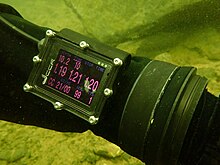
Some dive computers are able to calculate decompression schedules for breathing gases other than air, such as nitrox, pure oxygen, trimix or heliox. The more basic nitrox dive computers only support one or two gas mixes for each dive. Others support many different mixes.[37] When multiple gases are supported, there may be an option to set those which will be carried on the dive as active, which sets the computer to calculate the decompression schedule and time to surface based on the assumption that the active gases will be used when they are optimal for decompression. Calculation of tissue gas loads will generally follow the gas actually selected by the diver,[21] unless there is multiple cylinder pressure monitoring to enable automatic gas selection by the computer.[36]
Most dive computers calculate decompression for open circuit scuba where the proportions of the breathing gases are constant for each mix: these are "constant fraction" dive computers. Other dive computers are designed to model the gases in closed circuit scuba (diving rebreathers), which maintain constant partial pressures of gases by varying the proportions of gases in the mixture: these are "constant partial pressure" dive computers. These may be switched over to constant fraction mode if the diver bails out to open circuit.[21] There are also dive computers which monitor oxygen partial pressure in real time in combination with a user nominated diluent mixture to provide a real-time updated mix analysis which is then used in the decompression algorithm to provide decompression information.[17][19]
Freediving computers
A dive computer will record dive details automatically while the diver is underwater, and the length of the surface interval between dives. It records each dive, so there is a record of the number of dives. This is useful to ensure adequate surface interval to clear carbon dioxide buildup.[38]
Surface interval times are also useful to monitor to avoid taravana, the freediving decompression sickness. A dive computer is also the most effective way to notify the diver of the depth at which free-fall should start by a free-fall alarm. monitoring descent and ascent speed, and verifying maximum depth are also useful when training for efficiency.[39]
Two types of freediving computer are available, the ones that are dedicated to freediving, and those that are also scuba decompression computers, with a freediving mode. A stopwatch is useful for timing static apnea, rechargeable batteries are an option in some models, and GPS can be useful for spearfishers who wish to mark a place and return to it later. A few models offer a heart rate monitor.[40]
Additional functionality and features
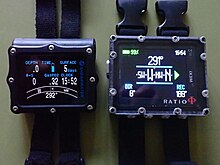

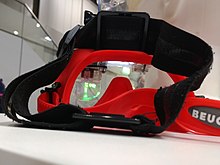
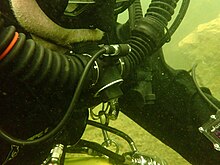
Some dive computers provide additional functionality, generally a subset of those listed below:
- Breathing gas oxygen analyser[16]
- Electronic compass[16]
- Gas blending calculator[16]
- Global navigation satellite receiver (only works at the surface)[16]
- Light-meter[16]
- Lunar phase indicator (useful for estimating tidal conditions)[16]
- Magnetometer (for detecting ferrous metal)[16]
- Pitch and roll angle[16]
- Stopwatch[16]
- Time of day in a second time zone[16]
- Time to surface after another 5 minutes at current depth on current gas.[41]
- Gauge mode (overrides decompression monitoring, and just records and displays depth and time and leaves the diver to control decompression by following tables).[16] Selecting gauge mode may reset the tissue saturation records to default, which invalidates any further decompression calculations until the diver has fully desaturated.[21]
- Air integration (AI)– Some dive computers are designed to measure, display, and monitor pressure in one or more diving cylinders. The computer is either connected to the first stage by a high pressure hose, or uses a wireless pressure transmitter on the regulator first stage to provide a wireless data signal indicating remaining cylinder pressure, The signals are encoded to eliminate the risk of one diver's computer picking up a signal from another diver's transducer, or interference from other sources.[42] Some dive computers can receive a signal from more than one remote pressure transducer.[11] The Ratio iX3M Tech and others can process and display pressures from up to 10 transmitters.[36]
- Workload modification of decompression algorithm based on gas consumption rate from integrated gas pressure monitor.[2]
- Heart rate monitor from remote transducer. This can also be used to modify the decompression algorithm to allow for an assumed workload.[2]
- Graphic display of calculated tissue compartment inert gas tensions during and after the dive.[21]
- Indication of computed decompression ceiling in addition to the more usual next stop depth. The effects on decompression risk of following the ceiling rather than remaining below the stop depth is not known, but stop depths are arbitrarily chosen for the calculation of decompression tables, and time spent at any depth below the indicated ceiling depth is processed by the same algorithm.[21]
- Display of supersaturation of limiting tissue as a percentage of M-value in the event of an immediate ascent.[21] This is an indicator of decompression risk in the event of an emergency ascent.
- Display of current supersaturation of limiting tissue as a percentage of M-value during ascent.[21] This is an indication of decompression stress and risk in real time.
- Multiple active gases for open circuit and closed circuit diluent.[21]
- Deactivation of gas options during dive in case of lost gas.[21] This will trigger the computer to recalculate the estimated time to surface without the deactivated gases.
- Definition of a new gas during the dive to allow calculations for decompression on gas supplied by another diver.[21]
- Battery charge status.[16][21]
- Alternative decompression algorithms.[21][17]
Features and accessories of some models:
- Piezo-electric buttons (no moving parts)[21][15]
- User input by directional tapping [15]
- Rechargeable batteries.[16]
- Wireless charging.[18]
- Optional battery types. For example the Shearwater Perdix and Petrel 2 can use 1.5V alkaline cells or 3.6V lithium cells provided they have the same physical format (AA).[43]
- User changeable batteries.[43]
- Battery redundancy.[15]
- User selected display colours (useful for the colour-blind), and variable brightness.[21][16]
- Screen inversion for ambidextrous use of units with plug-in cable connections for oxygen monitors.[19][21]
- Mask or mouthpiece mounted head-up display. (NERD)[44]
- Wireless downloading of dive log data.[21]
- Firmware upgrades over the Internet via Bluetooth or USB cable from smart phone or personal computer.[21][16]
- Display prompts for changing settings.[21]
- Twin straps or bungee straps for improved security.[21]
- Strap extensions for wristwatch format computers to allow for fitting over the forearm on bulky diving suits.
- Aftermarket straps, for improved security.
- Screen protectors, in the form of a self-adhesive transparent plastic film or a rigid transparent plastic cover.[21]
- Software for downloading, display and analysis of logged data. Most downloadable dive computers have a proprietary application, and many can also interface with open source software such as Subsurface. Some can down and upload via a smartphone to the cloud.[18]
Housed smartphones
Smartphones in underwater housings running a decopression monitoring app may be able to take photos or video as well, provided the housing is suitable.[13]
Safety and reliability
The ease of use of dive computers can allow divers to perform complex dives with little planning. Divers may rely on the computer instead of dive planning and monitoring. Dive computers are intended to reduce risk of decompression sickness, and allow easier monitoring of the dive profile. Where present, breathing gas integration allows easier monitoring of remaining gas supply, and warnings can alert the diver to some high risk situations, but the diver remains responsible for planning and safe execution of the dive plan. The computer cannot guarantee safety, and only monitors a fraction of the situation. The diver must remain aware of the rest by personal observation and attention to the ongoing situation. A dive computer can also fail during a dive, due to malfunction or misuse.[45]
Failure modes and probability of failure
It is possible for a dive computer to malfunction during a dive. Manufacturers are not obliged to publish reliability statistics, and generally only include a warning in the user manual that they are used at the diver's own risk. Reliability has markedly improved over time, particularly for the hardware.[46]
Hardware failures
Mechanical and electrical failures:
- Leaks allowing ingress of water to the electronic components, may be caused by:
- Cracked faceplate, which is more likely with hard, scratch-resistant glass and sapphire used on watch format units. They are strong, but brittle, and can shatter under impact with a sufficiently hard point contact.
- Seal failures can occur at joints, probably most often at the battery closure, as it is usually the most often disturbed. Computers with user serviceable batteries often use a double O-ring barrel seal to provide a more reliable seal.
- Button failures are one of the more frequent problems, some models are particularly susceptible. Occasionally the failure is in the form of leaks, but more often the switch fails open, which is sometimes a fatigue problem. Pressure sensitive switches with no moving parts are sometimes used to avoid this problem.
- Circuitry failures, other than switch failures, often due to water or battery leaks causing internal corrosion.
- Battery failure, such as running down unexpectedly, leaking, or failing to charge properly. Internal rechargeable batteries exchange a lower risk of water leaks for a higher risk of battery degradation over time.
- Non-rechargeable lithium batteries can explode if incorrectly used in a dive computer with charging facilities.[47]
This section needs expansion. You can help by adding to it. (June 2021) |
Software failures and reliability issues
There have been several instances where dive computers have been recalled due to significant safety issues in the software or factory calibration.[48] Earlier dive computers had to have software upgrades at the factory or an approved agent. This has changed and as of 2024, it is common to be able to update firmware over the internet, via bluetooth or a similar procedure.[21]
A series of Uwatec Aladin Air X NitrOx dive computers made in 1995 was recalled in 2003 due to faulty software which miscalculated desaturation time, leading to at least seven cases of DCS attrubuted to their use.[49] This is not the only recall for faulty software or calibration, Suunto D6 and D9s were recalled in 2006, Oceanic Versa Pro 2A in 2006, and Dacor Darwin computers in 2005, but no injuries were reported, and the units were recalled relatively soon after the problems were reported.[50][51][52] The Uwatec Aladin Air X Nitrox recall occurred during a class action suit and after several related lawsuits against the company and several alleged cover-ups, starting as early as 1996.[53][54][55][56] The case was settled on the eve of trial.[57]
Inherent risk
The main problem in establishing decompression algorithms for both dive computers and production of decompression tables, is that the gas absorption and release under pressure in the human body is still not completely understood. Furthermore, the risk of decompression sickness also depends on the physiology, fitness, condition and health of the individual diver. The safety record of most dive computers indicates that when used according to the manufacturer's instructions, and within the recommended depth range, the risk of decompression sickness is low.[7]
Zdroj:https://en.wikipedia.org?pojem=Bottom_timer
Text je dostupný za podmienok Creative Commons Attribution/Share-Alike License 3.0 Unported; prípadne za ďalších podmienok. Podrobnejšie informácie nájdete na stránke Podmienky použitia.
Antropológia
Aplikované vedy
Bibliometria
Dejiny vedy
Encyklopédie
Filozofia vedy
Forenzné vedy
Humanitné vedy
Knižničná veda
Kryogenika
Kryptológia
Kulturológia
Literárna veda
Medzidisciplinárne oblasti
Metódy kvantitatívnej analýzy
Metavedy
Metodika
Text je dostupný za podmienok Creative
Commons Attribution/Share-Alike License 3.0 Unported; prípadne za ďalších
podmienok.
Podrobnejšie informácie nájdete na stránke Podmienky
použitia.
www.astronomia.sk | www.biologia.sk | www.botanika.sk | www.dejiny.sk | www.economy.sk | www.elektrotechnika.sk | www.estetika.sk | www.farmakologia.sk | www.filozofia.sk | Fyzika | www.futurologia.sk | www.genetika.sk | www.chemia.sk | www.lingvistika.sk | www.politologia.sk | www.psychologia.sk | www.sexuologia.sk | www.sociologia.sk | www.veda.sk I www.zoologia.sk

